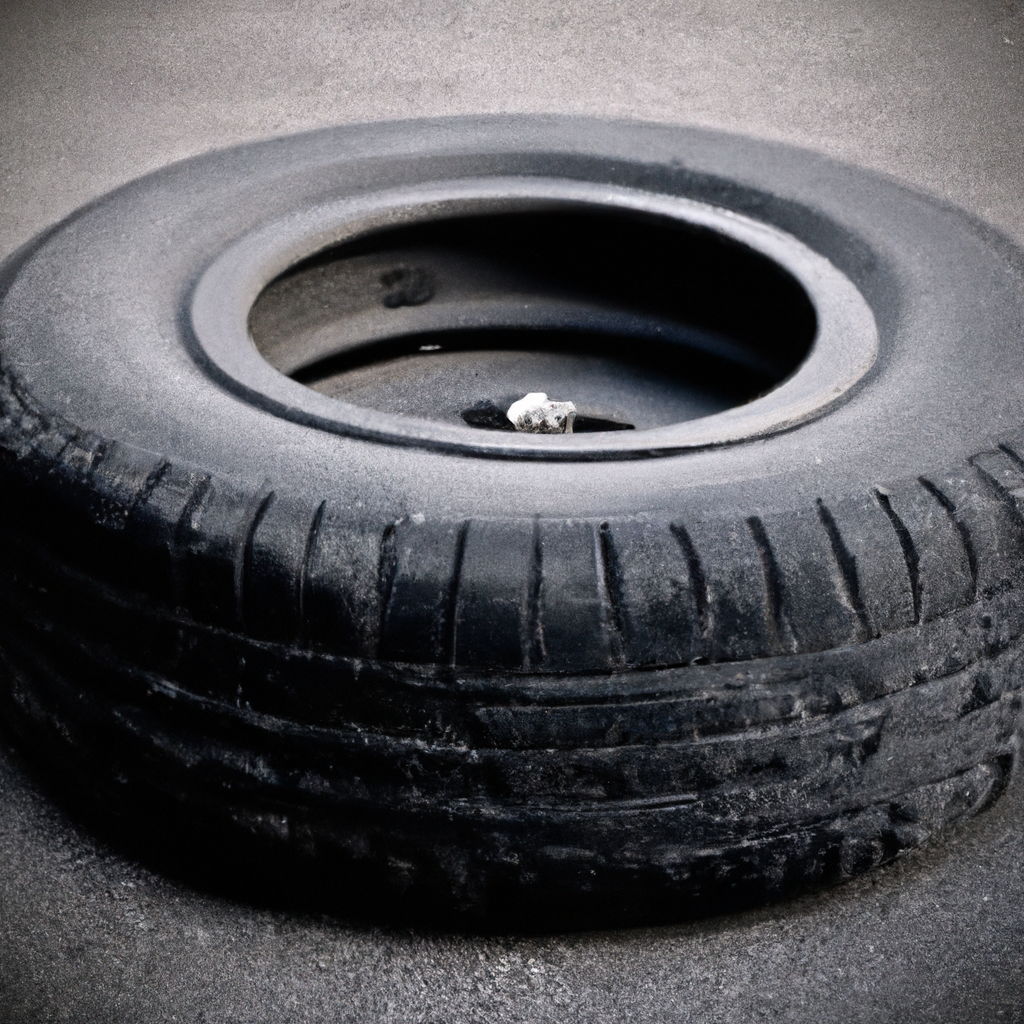When it comes to replacing a damaged tire, the question often arises: can I get away with just replacing one tire, or do I need to replace them all? It’s a common dilemma faced by many drivers, and in this article, we’ll explore the answer to this pressing question. So, let’s get down to it and find out if replacing only one tire is a viable option or not.

How to Assess Tire Damage
Inspect the damaged tire
When assessing tire damage, the first step is to carefully inspect the damaged tire. Look for any visible signs of wear, cuts, or punctures. Pay close attention to the tread and sidewall of the tire, as these are the areas most susceptible to damage. It’s important to thoroughly examine the tire to determine the extent of the damage and if it can be repaired or if a replacement is necessary.
Check for signs of irreparable damage
While inspecting the damaged tire, it’s essential to check for any signs of irreparable damage. If the tire has a sidewall bulge, a tear in the sidewall, or a puncture in the sidewall or shoulder area, it is generally considered irreparable. Additionally, if the tread depth is below the legal limit or the tire is severely worn, it may not be safe to continue using it. Identifying irreparable damage is crucial in determining whether the tire should be replaced.
Assess tread wear on other tires
When evaluating tire damage, it’s important to consider the condition of the other tires on your vehicle. If the damaged tire has uneven tread wear compared to the other tires, it may indicate an alignment or suspension issue. In such cases, it may be necessary to replace more than one tire to maintain optimal performance and safety.
Consider the tire’s age
Another factor to consider when assessing tire damage is the age of the tire. Tires have a limited lifespan, typically around six years, regardless of their tread depth. As tires age, they become more prone to failure and can develop cracks or dry rot. If the damaged tire is nearing the end of its lifespan, it may be wise to replace all tires to ensure your safety on the road.
Consult with a professional
If you’re unsure about the extent of the tire damage or the best course of action, it is always recommended to consult with a professional. A tire specialist or automotive technician can provide expert advice and guide you in making an informed decision. They can assess the tire damage, consider other factors specific to your vehicle, and recommend the most suitable options for replacement.
When to Replace Only One Tire
When the damaged tire is relatively new
In certain situations, it is possible to replace only one tire, especially if the damaged tire is relatively new and the other tires are still in good condition. If the damaged tire is barely used and has significant tread life remaining, replacing it alone can be a cost-effective solution.
When the other tires are still in good condition
Replacing only one tire may also be appropriate when the other tires on your vehicle are in good condition. If the remaining tires have even tread wear, sufficient tread depth, and are free from any signs of damage, it may not be necessary to replace them all. In such cases, replacing only the damaged tire can help maintain balance and uniformity in your tire set.
When the tire damage is repairable
Some types of tire damage, such as small punctures or minor cuts, can be repaired by a professional tire repair technician. If the damage is deemed repairable and meets the industry’s repair guidelines, it may be possible to fix the tire instead of replacing it. This can save you money and extend the lifespan of the tire.
When the vehicle has all-wheel drive
If your vehicle is equipped with all-wheel drive (AWD) or four-wheel drive (4WD), it is generally recommended to replace all four tires simultaneously. However, when only one tire is damaged and the other three tires are still in good condition, replacing only the damaged tire might be a suitable option. It is crucial to refer to the vehicle manufacturer’s recommendations in such situations to ensure optimal performance and safety.
The Importance of Tire Uniformity
Understanding tire uniformity
Tire uniformity refers to the consistency of a tire’s construction and performance characteristics. When tires are uniformly matched in terms of size, tread pattern, and other performance factors, they work harmoniously together to provide balanced handling and performance.
The effects of mismatched tires
Using mismatched tires, whether in terms of size, brand, or performance characteristics, can have detrimental effects on your vehicle’s performance and safety. Mismatched tires can negatively impact braking distances, cornering stability, and traction, leading to potential accidents and decreased overall handling capabilities.
Maintaining balanced handling and performance
By ensuring tire uniformity, you can maintain balanced handling and performance on the road. Matching the size, tread pattern, and performance characteristics of your tires contributes to even wear, improved traction, and enhanced vehicle stability. This not only provides a safer driving experience but also prolongs the lifespan of your tires.
Considerations for Replacing Only One Tire
Matching the tread pattern
When replacing only one tire, it is crucial to consider matching the tread pattern as closely as possible to the other tires on your vehicle. The tread pattern affects the tire’s grip on different road surfaces and influences its performance characteristics. By keeping the tread pattern consistent across all tires, you can maintain balanced handling and prevent potential mismatches in performance.
Choosing a tire with similar performance characteristics
Selecting a replacement tire with similar performance characteristics is essential when replacing only one tire. Consider factors such as the tire’s load capacity, speed rating, and overall handling capabilities. By choosing a tire that closely matches the performance of the existing tires, you can ensure uniformity in your tire set and maintain a consistent driving experience.
Considering the vehicle manufacturer’s recommendations
To make the best decision when replacing only one tire, it is advisable to consult the vehicle manufacturer’s recommendations. The manufacturer’s guidelines take into account various factors specific to your vehicle, such as suspension setup, weight distribution, and intended use. By following these recommendations, you can ensure optimal performance, safety, and longevity of your tires.

Potential Risks of Replacing Only One Tire
Reduction in traction and stability
Replacing only one tire can lead to differences in tread depth and tread pattern among the tires on your vehicle. These differences can result in reduced traction and stability, particularly in wet or slippery conditions. Having unmatched tires can compromise your ability to effectively control your vehicle, leading to potential accidents.
Uneven tread wear and decreased tire lifespan
Using one tire that is significantly different from the others can cause uneven tread wear and decrease the overall lifespan of your tires. The mismatched tire may wear more quickly or unevenly, which can result in the need for premature replacement. Uneven tread wear can also affect your vehicle’s handling, leading to decreased performance and safety.
Impact on vehicle systems
Mismatched tires can have an impact on various vehicle systems, such as the ABS (anti-lock braking system) and traction control. These systems rely on consistent tire size, tread pattern, and performance to function optimally. Using tires that do not match can disrupt these systems and compromise their effectiveness, potentially affecting your vehicle’s safety features.
Factors to Consider when Replacing All Tires
Balancing tire wear and performance
Replacing all tires ensures that they are consistent in terms of wear, tread depth, and performance characteristics. When all four tires have the same level of wear, there is a balance in traction, braking, and handling capabilities. By replacing all tires simultaneously, you can maintain optimal performance and safety on the road.
Avoiding mismatched tires
Replacing all tires eliminates the risk of having mismatched tires, which can negatively impact overall performance and safety. It ensures that all tires have the same tread pattern, size, and performance characteristics, providing consistent handling and traction. By avoiding mismatched tires, you can enhance your driving experience and reduce the risk of accidents.
Getting better handling and traction
By replacing all tires at once, you can experience better handling and traction on the road. New tires have deeper tread depth and improved rubber compound, providing enhanced grip and responsiveness. With all new tires, you can expect improved steering control, shorter braking distances, and increased overall stability.

When to Replace All Tires
When all tires have significant wear
If all four tires show signs of significant wear, it is recommended to replace all tires to maintain optimum safety and performance. Tires with low tread depth have reduced traction and are more prone to hydroplaning, especially on wet roads. By replacing all tires, you can restore the grip and handling capabilities of your vehicle, ensuring a safer driving experience.
When there is a puncture in the sidewall
A puncture in the sidewall is a severe form of tire damage that cannot be repaired. Sidewall punctures compromise the structural integrity of the tire, making it unreliable and unsafe to use. If one of your tires has a sidewall puncture, it is crucial to replace all of your tires to ensure consistent performance and reduce the risk of a sudden tire failure.
When the damaged tire cannot be repaired
If the damaged tire cannot be repaired due to its condition or the severity of the damage, it is advisable to replace all tires. While it may be tempting to replace only the damaged tire, the mismatched wear and performance characteristics can compromise the handling and safety of your vehicle. Replacing all tires ensures uniformity and provides optimal performance on the road.
When vehicle system requirements demand it
Certain vehicles have specific requirements regarding tire replacement, especially those equipped with advanced safety systems or complex drivetrain configurations. It is crucial to refer to the vehicle manufacturer’s recommendations to determine if replacing all tires is necessary to maintain the proper functioning of these systems. Ignoring these requirements can compromise your safety and the performance of your vehicle.
Cost Considerations
Comparing the cost of one tire vs. a set of tires
When considering whether to replace one tire or a set of tires, it’s important to compare the costs involved. While replacing only one tire may seem like a more budget-friendly option initially, it’s essential to consider the potential costs of replacing additional tires in the near future. A complete set of tires may offer better long-term value and avoid the hassle and expense of multiple replacements.
Potential savings with a full tire replacement
Opting for a full tire replacement can potentially lead to savings in the long run. When replacing all tires at once, you may be able to take advantage of special deals or discounts offered by tire manufacturers or retailers. Additionally, you can avoid the costs associated with mounting and balancing multiple tires over time, as well as potential alignment issues that can arise when replacing tires individually.
Long-term maintenance and safety benefits
Replacing all tires as a set can provide long-term maintenance and safety benefits. New tires offer optimal performance, improved fuel efficiency, and enhanced safety features, such as shorter braking distances and better traction. By investing in a complete set of tires, you are prioritizing your safety and reducing the likelihood of premature tire failure or compromised performance.

Consulting with a Professional
Seeking advice from a tire specialist
When faced with the decision of whether to replace one tire or all tires, it is highly recommended to seek advice from a tire specialist. Tire specialists have the expertise and knowledge to assess the condition of your tires, understand your specific vehicle requirements, and offer recommendations based on industry standards. Their professional guidance can help you make an informed decision and ensure the safety and performance of your vehicle.
Getting a professional inspection
If you are uncertain about the extent of the tire damage or the overall condition of your tires, it’s beneficial to get a professional inspection. Tire professionals can thoroughly examine your tires, identify any potential issues, and provide an accurate assessment of their condition. A professional inspection can give you peace of mind and help you determine whether one tire replacement is sufficient or if all tires should be replaced.
Considering the specific needs of your vehicle
Every vehicle has unique characteristics and requirements when it comes to tire replacement. It is essential to consider the specific needs of your vehicle, such as the recommended tire size, load capacity, and speed rating. By taking these factors into account and consulting with a professional, you can ensure that the tires you choose align with your vehicle’s specifications and provide optimal performance and safety.
Conclusion
Assessing tire damage and determining whether to replace only one tire or all tires requires careful consideration of various factors. By inspecting the damaged tire, checking for irreparable damage, assessing tread wear on other tires, considering the tire’s age, and consulting with a professional, you can make a well-informed decision. Understanding the importance of tire uniformity and the potential risks of replacing only one tire further aids in determining the most suitable course of action. Factors such as matching the tread pattern, choosing a tire with similar performance characteristics, and following the vehicle manufacturer’s recommendations also play a significant role. Ultimately, cost considerations, potential savings, and the long-term maintenance and safety benefits should be taken into account. By consulting with a tire specialist, getting a professional inspection, and considering the specific needs of your vehicle, you can confidently decide whether to replace one tire or all tires, ensuring optimal performance, safety, and peace of mind on the road.


